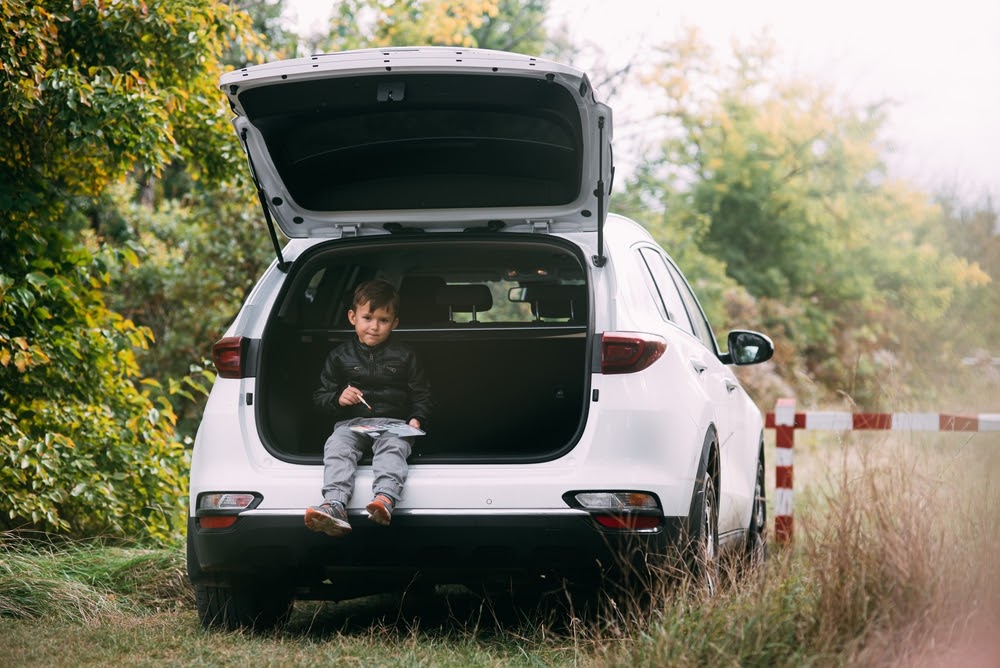Small SUVs Ranked by Towing Capacity
Sports utility vehicles (aka SUVs) are offered in small, midsize and full-size models. Larger models could be popular choices for those who need space for lots of passengers or individuals who need a decent amount of cargo room and strength for towing, too.
Yet, car buyers who need to tow a small camper or a kayak but who can’t afford to spend the price for a large SUV model or who maybe don’t feel comfortable navigating such a large model could opt for a small SUV instead. Here are all the moderately-priced small SUVs ranked by towing capacity.
A Roundup of All the Models
There are almost a dozen small SUV models on the market. Price ranges vary, but most hover in the mid-$20K range. Models offer similar towing capacities, too. Here are all the models sorted by maximum towing capacity (least to greatest).
MSRP: $26,050
Safety Rating: Top Safety Pick+
Towing Capacity: 1,350 pounds
- 2022 GMC Terrain
MSRP: $27,900
Towing Capacity: 1,500 pounds
MSRP: $25,800
Towing Capacity: 1,500 pounds
MSRP: $25,750
Safety Rating: Top Safety Pick
Towing Capacity: 1,500 pounds
- 2022 Volkswagen Tiguan
MSRP: $25,995
Safety Rating: Top Safety Pick (for 2021)
Towing Capacity: 1,500 pounds
MSRP: $26,010
Safety Rating: Top Safety Pick
Towing Capacity: 1,500 to 3,500 pounds
MSRP: $25,195
Towing Capacity: 1,500 to 3,000 pounds
MSRP: $24,090
Safety Rating: Top Safety Pick
Towing Capacity: 1,653 pounds
MSRP: $25,370
Safety Rating: Top Safety Pick+
Towing Capacity: 2,000 pounds
MSRP: $25,350
Safety Rating: Top Safety Pick+
Towing Capacity: 2,000 pounds
MSRP: $26,350
Safety Rating: Top Safety Pick
Towing Capacity: 2,500 pounds
The Small SUV with the Best Towing Capacity
Car buyers looking for the best small SUV for towing have several choices. Both the Ford Escape and the Subaru Forester offer a towing capacity that varies from 1,500 pounds to 3,000 and the RAV4 offers a maximum towing capacity of 2,500 pounds.
The Escape and the RAV4 also both received Top Safety Pick ratings from the Insurance Institute for Highway Safety (IIHS). In addition, all three models are comparable in price. The Subaru Forester is the least expensive option with a base price of $25,195.

Do Other Models Pull Their Weight?
The other remaining models offer around the same towing capacity—about 1,500 to 2,000 pounds. The Nissan Rogue offers the lowest towing capacity, pulling only 1,350 pounds.
Since models are quite comparable in their towing capacity, buyers might look at price and safety or other features to guide their final purchase decision. The Hyundai Tucson, Nissan Rogue and Mazda CX-5 were rated the highest in safety by the IIHS, with a Top Safety Pick+ rating.
Small SUVs are not designed, however, to tow massive loads. While these models could be fine pulling kayaks, canoes or other lighter items, they aren’t the option for buyers who need to pull large campers.
Buyers may need to upgrade to a midsize model SUV, if they want a bit more power for towing. Luxury models like the Audi Q5 or the Land Rover Discovery Sport could be great choices—both can tow more than 4,400 pounds. The 2022 Audi Q5 received a Top Safety Pick+ rating from the IIHS; the model has a base price of $45,600.
The Jeep Cherokee is the best mid-sized option for towing, though. The Cherokee can pull 4,500 pounds. The Cherokee also is moderately priced at $27,890.
Weighing the Best Options
Buyers might not be sure which model is right for their needs. With so many options with similar specs, it becomes a bit more difficult to find the best choice. Ultimately, the choice may come down to budget and the price that the buyer is willing to spend or can afford to spend.
New models may be more expensive than used models. Used luxury models, however, could be priced higher.
When setting a budget for a new car, though, experts recommend spending less than 10 percent of monthly take home pay on that monthly car payment, and the total cost of transportation should be kept to less than 20 percent of monthly take home pay.
What is take-home pay? This is the amount that is left from a paycheck after taxes and other deductions (like medical insurance). Take-home pay is not the total salary an individual earns.
Transportation costs related to car ownership include the monthly payment, the price of fuel (or electricity for eco models) and car insurance. In total, these expenses make up the price of the car each month.
Car buyers tend to focus on simply the monthly payment when budgeting for a new car. They need to remember, though, that a new car might cost more to insure, which means monthly premiums might increase.
Fuel needs also may be different. Small SUVs may be more fuel efficient than larger models. However, if a car owner is used to driving a small car, they may face increased costs at the pump by upgrading to a small SUV.
For buyers that don’t know how much they may be able to secure in financing, Nerdwallet offers an easy tool to calculate how much a buyer could borrow based on their income and credit score. When using Nerdwallet’s tool, remember to follow the guidelines based on take-home pay.

Shopping During a Supply Crunch
Some buyers prefer new vehicles, but others are looking for the best price among pre-owned options. Buying new or used cars could just be a preference.
When shopping used inventory, the age, mileage, make/model and condition all could impact the price of the vehicle. However, another major factor also can play a role: supply. When supply is low, buyers might not have much selection. Prices also could be higher.
Car dealerships have faced times where car lots are nearly empty. When this happens, the buyer might have to purchase what they can find. This can make finding the best vehicle much harder, and it might be more difficult to find thrifty options, too.
During times of supply crunch, buyers may need to do their research ahead of time. If they’re looking for a small SUV for towing, they may need to review all the options and have a backup plan in place. For those who really want a RAV4, they may be flexible and shop for a Honda CR-V.
Many small SUVs are comparable in price and towing capacity. Buyers may have a brand loyalty or preference, but when supply is tight buyers may need to make a few concessions.
Buyers shopping during a supply drought should know their needs, and have multiple backup models on their list in case their top choice is nowhere to be found on the lot. They also may research brands they’ve never purchased.
Maybe a buyer is unfamiliar with Kia but knows that the brand offers a small SUV. Visit the manufacturer’s sites to learn all about the models. Then visit the IIHS and research safety ratings.
Exploring the Options Online
Many buyers begin their research process online. Sites like Kelley Blue Book (KBB) and IIHS can help buyers find specs and prices as well as safety data on the models that interest them.
Dealership sites are the best destinations for uncovering available inventory. In addition, buyers may want to see what types of incentives and promotions each dealership is offering.
RelayCars also can help buyers explore cars from home via augmented reality and 3D imagery. RelayCars offers an immersive library of thousands of cars. Just choose the model that the buyer wants to view and begin exploring.
RelayCars gives users the option to view the vehicle via a 3D image or in augmented reality. With 3D images, the user can rotate a model image of the vehicle in 360 degrees; view the car from any angle. They also can choose to view the model in different paint colors.
With augmented reality, the user can choose where they want to view the vehicle. Augmented reality uses the camera of a smartphone or tablet to superimpose an image of the vehicle in the user’s own environment.
View the car in a bedroom, in the garage or see how it looks in the driveway. The car is displayed in full scale, and, using the camera function of the device, an individual can actually walk around the vehicle. This gives users an immersive way to explore the vehicle.
Auto brands also could offer immersive augmented reality experiences. When buyers are researching their vehicle options, they can visit the manufacturer’s websites to explore any augmented or virtual reality viewing experiences.
In addition, buyers also can visit YouTube to check out any videos about their favorite models. Some dealerships offer virtual test drives via YouTube. These videos can help buyers get a better understanding of the vehicle.
Buyers who are only focused on the towing capacity of a small SUV, though, may find that their options are very similar in price and perhaps design, too. Using third-party sites and resources can help buyers gain more information about their options, especially if they need to have multiple backup options on their list during times of inventory shortages.
Recent Posts
Categories
Luxury Cars
Trucks
Sedans
